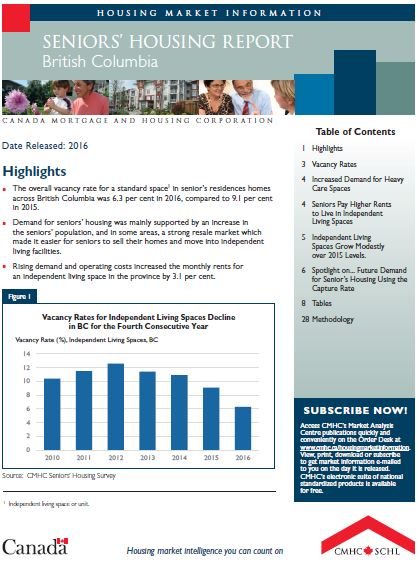Canada Mortgage and Housing Corporation (CMHC) released its annual Seniors’ Housing Report – British Columbia today. According to the 2016 CMHC Seniors’ Housing Survey, the vacancy rate for independent living spaces in British Columbia was 6.3 per cent in 2016 compared to 9.1 per cent in 2015. The report also indicates that the vacancy rate for publicly subsidized care homes is near zero percent.
Report Highlights
The vacancy rate for complex care spaces in BC lowered in 2016, moving from 1.8 per cent in 2015 to 1.3 per cent. Vacancy rates for market complex care spaces moved down from 8.4 per cent in 2015 to 7.2 per cent in 2016, while the vacancy rate for non-market complex care spaces went to zero. The demand for non-market complex care spaces remains high due to the high costs associated of living in these spaces, which cater to seniors with health challenges and require more complex types of care than provided in an independent living residence. However, demand for market units in complex care homes increased as some seniors were more able or willing to pay higher costs on
a temporary basis, while being on a waitlist to have a publicly-funded unit in the same residence.
“These are very stark statistics,’ says Daniel Fontaine, CEO for the BC Care Providers Association. “As our population rapidly ages we must ensure we continue to make new investments in seniors care and housing to ensure we have adequate supply in order to meet an identified demand.”
2016 was also the fourth consecutive year that the vacancy rate for independent living spaces declined in British Columbia, attributed mainly to population growth among people aged 75 and up.
“The Seniors Housing Report found that the vacancy rate for independent living spaces in British Columbia declined for the fourth year in a row,” says Richard Sam, Market Analyst with the CMHC. “The main driver for this is the growing seniors population and in some areas, a strong resale market that has made it easier for seniors to sell their homes and move into facilities that better suit their needs”
The lowest vacancy rate for independent living spaces-3.6 per cent–was recorded in the “Other BC” region (comprised mostly of areas in Northern BC and the Kootenays).
The Okanagan/Thompson/Shuswap region recorded the highest rent increase over 2015 levels in British Columbia at 4.2 per cent. The Lower Mainland recorded the highest rent level at $3,239 per month.

Total independent living spaces in CMHC’s Seniors Survey grew moderately in British Columbia to 30,605 spaces in 2016 from 30,194 in 2015. Independent living spaces increased by over one-thousand units and heavy care spaces declined by 431 units.
Canada Mortgage and Housing Corporation conducts the Seniors’ Housing Survey annually in February and March. The Seniors’ Housing Survey is a census and not a sample survey; therefore, to be included in the survey all seniors’ residences in British Columbia must meet the following criteria: have been in operation for one year, have at least 5 units or spaces, offer an on-site meal plan, not mandate high levels of health care, pay a monthly rent and have at least 50 per cent of its residents 65 years of age or older.
As Canada’s authority on housing, CMHC contributes to the stability of the housing market and financial system, provides support for Canadians in housing need, and offers objective housing research and information to Canadian governments, consumers and the housing industry.
For more information, visit the CHMC website or follow them on Twitter, YouTube, LinkedIn and Facebook.
[Note: Some of the above information was supplied directly via a Marketwire news release issued by CHMC]. To learn more, you can listen to a Simi Sara interview with Richard Sam conducted at 6:20 am on Wednesday, June 15th on CKNW radio. Please visit their “audio vault” to access the recording.




